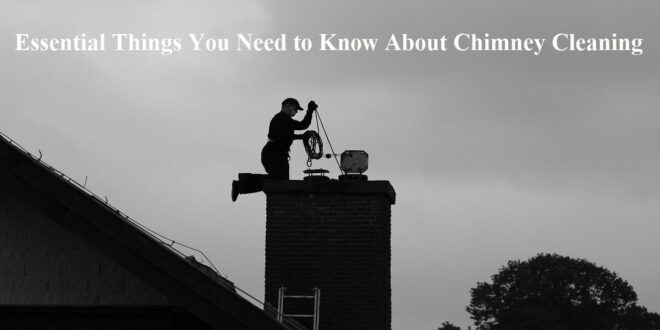Several features can make a house more welcoming. One of them is a fireplace. For it to perform excellently, you must consider some maintenance duties.
Regular chimney cleaning is important because all the soot and smoke created in a fireplace go away via the vent. Other important things that you ought to know when it comes to cleaning your smokestack are as follows.
Common Problems that Need a Chimney Sweep
If your home lacks a fireplace, it is high time you consider its addition. Cleaning a smoke conduit is a bit more complicated than cleaning a fireplace. This is because it may have numerous issues which are hard to detect.
You might be knowledgeable on how to clean a chimney. Nevertheless, there are some underlying issues only an expert can discover. Failure to repair the problems fast can result in more expensive problems with your smokestack.
Below is an outline of a chimney’s major issues and demand for cleaning.
Creosote
This is a carcinogenic chemical that forms on a smoke stack wall when the wood is burning. Even though it is a native byproduct, regularly failing to clean it can cause chimney fires.
Flue Buildup
A smokestack flue is a place where creosote collects. Indeed, most of the smokestack cleaning takes place here. At times, it might need repair. But, keep in mind that this can only be discovered by conducting a thorough inspection as well as cleaning.
Carbon monoxide can get into your house when a chimney flue has cracks. Besides, because a flue has another role in protecting the explosive house parts, a cracked one makes your home more prone to catching fire.
Soot
The dark color fire byproduct you find on a smokestack wall is the soot. It features cancer-causing elements. Cleaning your smokestack enhances air quality and prevents corrosion of its other essential parts.
Dirty Damper
When the damper is closed, it prevents air from going outside your house whenever you are not using the fireplace. Thus, it has to be open when using the fireplace to allow the smoke out. The dirt in the damper means your smokestack is not clean and requires immediate cleaning.
Obstruction
The major obstruction in a smokestack is creosote. Other obstructions are dead rodents and leaves.
Signs Your Chimney Needs Cleaning
A lot of homeowners are tempted to light up the fireplace despite not cleaning it for a year. But, the truth is that you will find signs it requires to be cleaned.
An excellent example of this is a lot of soot and strange odor as you burn a fire. It is advisable to clean your smokestack whether or not there are signs.
If you have taken a year using your fireplace but have not attempted to clean it, you are not doing the right thing. Other major reasons you should have your vent clean are as follows.
Emergencies
At times, a smoke stack has so much buildup that it cannot allow you to use the fireplace. The only solution to this is to clean it. Otherwise, you will be forced to repair it so that it can work excellently. Unfortunately, repairing it can cost you a lot of money if the damages are severe.
An emergency cleaning of your chimney is necessary if you realize smoke is entering your house anytime the fireplace is on.
In addition, you need to call an emergency smokestack sweep if you have had a chimney fire recently or your carbon monoxide goes off repeatedly whenever you are using the fireplace.
Non-Emergencies
Cleaning your chimney should not only be done when there are emergencies. You can clean it to enjoy the benefits of a clean smokestack.
Some of the non-emergency reasons for sweeping chimneys include seeing dead animals landing at the fireplace or the fire not burning evenly. In addition, your smoke stack needs a yearly cleaning.
Other Reasons
Other reasons that can make you clean your smoke vent relate to décor. For example, if you are looking forward to painting your fireplace, you have to clean the chimney first to make sure the residue and debris do not fall and destroy the paint.
You can also choose to clean it if you want to renovate it. Another reason for doing this is when you want to sell your home.
How Frequently Should Chimney Cleaning Be Done?
A lot of people ask this question daily. You should wash it based on the times you use the fireplace. According to the National Fire Protection Association, it is important to inspect vents, fireplaces, and chimneys at least once a year. You should clean, maintain, and repair them when need be.
Not using a fireplace for a while should not be why you are not cleaning it. This is because raccoons, squirrels, birds, and other critters might have used it. It is not safe to use it in such a state devoid of clearing all the accumulated debris.
Professional chimney cleaners recommend considering cleaning it if you realize the sooty buildup in the smokestack is 1/8 inches.
When there is a lot of creosote and soot, it is deemed risky because it can lead to smoke stack fire which can damage it or spread fire to your entire home or roof. While cleaning the vent, make sure you clean the furnace flue systems.
Conclusion
Having a fireplace in your home is an excellent benefit because it ensures you are comfortable on cold nights and that your property is warm during the winter season. But, you have to keep it clean to enjoy its advantages to a home.
Chimney cleaning should be done at least once per year from the above guide. But, there are some issues like having smoke entering your house anytime the fireplace is in use that can call for emergency inspection and cleaning.
Failure to clean your furnace and the smokestack can accumulate dirt and debris that can cause a fire. This is dangerous as it burns your house roof or the entire house.
Hence, you should take your time to ensure its maintenance services are well-considered to avoid this. Doing this gives you a guarantee of using your furnace comfortably.
 Make Home Smart Let's Make Smart Home for Everyone!
Make Home Smart Let's Make Smart Home for Everyone!




